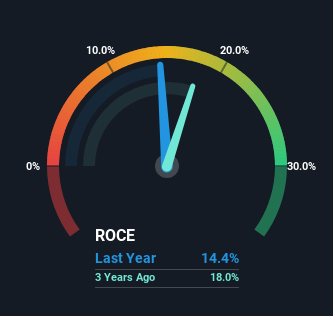Power Root Berhad (KLSE:PWROOT) Is Looking To Continue Growing Its Returns On Capital
To find a multi-bagger stock, what are the underlying trends we should look for in a business? Typically, we'll want to notice a trend of growing return on capital employed (ROCE) and alongside that, an expanding base of capital employed. If you see this, it typically means it's a company with a great business model and plenty of profitable reinvestment opportunities. Speaking of which, we noticed some great changes in Power Root Berhad's (KLSE:PWROOT) returns on capital, so let's have a look.
Understanding Return On Capital Employed (ROCE)
For those that aren't sure what ROCE is, it measures the amount of pre-tax profits a company can generate from the capital employed in its business. Analysts use this formula to calculate it for Power Root Berhad:
Return on Capital Employed = Earnings Before Interest and Tax (EBIT) ÷ (Total Assets - Current Liabilities)
0.14 = RM54m ÷ (RM492m - RM114m) (Based on the trailing twelve months to December 2023).
So, Power Root Berhad has an ROCE of 14%. That's a pretty standard return and it's in line with the industry average of 14%.
Check out our latest analysis for Power Root Berhad
Above you can see how the current ROCE for Power Root Berhad compares to its prior returns on capital, but there's only so much you can tell from the past. If you'd like, you can check out the forecasts from the analysts covering Power Root Berhad for free.
What The Trend Of ROCE Can Tell Us
The trends we've noticed at Power Root Berhad are quite reassuring. Over the last five years, returns on capital employed have risen substantially to 14%. The amount of capital employed has increased too, by 71%. So we're very much inspired by what we're seeing at Power Root Berhad thanks to its ability to profitably reinvest capital.
On a related note, the company's ratio of current liabilities to total assets has decreased to 23%, which basically reduces it's funding from the likes of short-term creditors or suppliers. So shareholders would be pleased that the growth in returns has mostly come from underlying business performance.
What We Can Learn From Power Root Berhad's ROCE
To sum it up, Power Root Berhad has proven it can reinvest in the business and generate higher returns on that capital employed, which is terrific. And investors seem to expect more of this going forward, since the stock has rewarded shareholders with a 50% return over the last five years. Therefore, we think it would be worth your time to check if these trends are going to continue.
Like most companies, Power Root Berhad does come with some risks, and we've found 2 warning signs that you should be aware of.
While Power Root Berhad may not currently earn the highest returns, we've compiled a list of companies that currently earn more than 25% return on equity. Check out this free list here.
Have feedback on this article? Concerned about the content? Get in touch with us directly. Alternatively, email editorial-team (at) simplywallst.com.
This article by Simply Wall St is general in nature. We provide commentary based on historical data and analyst forecasts only using an unbiased methodology and our articles are not intended to be financial advice. It does not constitute a recommendation to buy or sell any stock, and does not take account of your objectives, or your financial situation. We aim to bring you long-term focused analysis driven by fundamental data. Note that our analysis may not factor in the latest price-sensitive company announcements or qualitative material. Simply Wall St has no position in any stocks mentioned.

 Yahoo Finance
Yahoo Finance 
